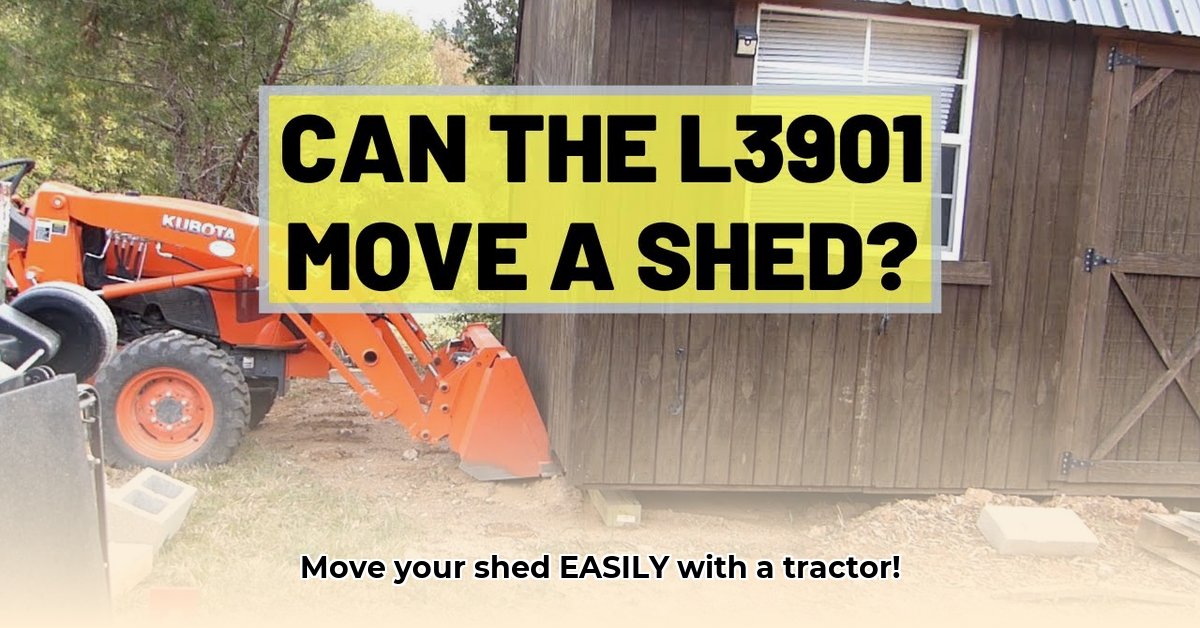
Moving a shed with a tractor can be a challenging but achievable task. This guide provides a step-by-step approach, emphasizing safety and covering different methods for various shed sizes and terrains. Remember, safety is paramount – always prioritize caution over speed. For more on moving smaller structures, check out this chicken tractor guide.
Getting Started: Planning Your Shed Relocation
Before you even start the engine, careful planning is crucial. Several factors determine the best approach:
Shed Size and Weight: Accurately assess your shed's dimensions and weight. A small wooden shed will require a different approach than a large, heavy metal structure. Use a measuring tape and consider using a weight scale if available, or estimate based on materials.
Terrain Assessment: Examine the ground between the shed's current location and its new destination. Is it level, sloped, muddy, or rocky? The terrain significantly impacts the method you should use. Uneven terrain necessitates a different method than level ground.
Tractor Capabilities: Check your tractor's towing capacity and ensure it can safely handle the shed's weight. Overloading a tractor can lead to accidents and equipment damage. Consult your tractor's owner's manual for its maximum towing capacity.
Obstacles: Identify and map out any obstacles along the path. This includes trees, rocks, underground utilities, and overhead power lines. Clear the path of any obstacles.
Method 1: The Direct-Pull Method (Smaller Sheds on Level Ground)
This method is suitable for smaller, lighter sheds on relatively flat, firm ground. However, it carries a higher risk if conditions aren't ideal.
Secure the Shed: Use heavy-duty chains or strong straps to attach the shed firmly to your tractor's hitch. Distribute weight evenly to prevent any tilting or stress on one side. Multiple attachment points are recommended. Critically examine the chains and straps for wear or damage before attaching.
Boost Traction (If Needed): For slightly uneven ground, add weight to your tractor's rear tires. Wheel weights or sandbags can enhance grip and traction, preventing wheelspin. This improves the probability of a successful move.
Engage the Differential Lock (If Available): If your tractor has a differential lock, engage it. This distributes power equally to the rear wheels, improving traction, especially on slippery surfaces. This significantly reduces the risks of wheelspin.
Move Slowly and Steadily: Begin slowly, monitoring the shed's movement. Maintain a slow, controlled pace to prevent sudden jolts or damage. Avoid sudden acceleration and braking. The speed should be slow enough to maintain control.
Enlist Helpers: Have at least one or two spotters to guide you and watch for obstacles. Their extra eyes significantly improve safety. Communication between the tractor operator and spotters is essential.
Method 2: The Roller System (Larger or Heavier Sheds, Uneven Terrain)
This method is preferable for larger, heavier sheds or uneven terrain. It reduces friction while making the process safer and more controlled.
Prepare the Path: Clear the intended path of any obstacles. The smoother the path, the easier (and safer) the move. This minimizes friction and chances of snagging.
Position the Rollers: Place heavy-duty rollers (consisting of a solid, cylindrical object used to reduce friction) under the shed's skids, ensuring even weight distribution. Use enough rollers to provide full support. Ensure all rollers are properly placed before attempting movement.
Lift and Balance: Use jacks to lift and balance the shed, carefully guiding it onto the rollers. This creates a more controlled movement, allowing smooth and even transition across the rollers. This helps in preventing the shed from tipping.
Attach the Tractor: Secure strong chains or straps to the shed, keeping them taut but not overly stressed. Distribute the weight evenly across multiple attachment points to prevent damage to the shed or tractor. Ensure the chains are properly hooked and secured.
Control the Movement: Slowly guide the shed using the tractor. Slow, deliberate movements are crucial to prevent shocks or damage to the shed. Maintaining a slow pace minimizes the risk of accidents.
Spotter Assistance: Spotters should remain present throughout the move to maintain proper control. Regular communication between the operator and spotters is very important to ensure safety.
Safety Precautions: Absolute Essentials
Safety should always be your top priority:
Pre-Move Inspection: Thoroughly inspect all equipment—tractor, chains, straps, rollers—for any damage or wear before starting. Identifying issues beforehand prevents catastrophic failures.
Safety Gear: Wear appropriate safety gear, including sturdy work boots, gloves, safety glasses, and a hard hat. Appropriate gear is less likely to damage the structure or injure yourself in the process.
Teamwork: Never work alone. Always have helpers to assist with maneuvering and spotting. Having other eyes on the process greatly increases safety.
Controlled Movements: Avoid jerky movements, sudden starts, and stops. Gradual, controlled movements minimize risks and damage. A smooth and controlled maneuver minimizes the risk of the shed tipping or the tractor skidding.
Environmental Awareness: Be aware of your surroundings, including obstacles, overhead power lines, and underground utilities. Maintaining awareness minimizes the risk of unseen issues.
Seek Professional Help: If unsure about any aspect of the process, seek professional advice. Professional help is always a better option than an accident.
Choosing the Right Method: Weighing the Pros and Cons
The optimal method depends on several factors. Consider carefully:
| Method | Advantages | Disadvantages |
|---|---|---|
| Direct Pulling | Simple, potentially faster for smaller sheds on level ground. | Limited to smaller, lighter sheds on level ground; higher risk of damage and tipping. |
| Roller System | Best for larger, heavier sheds and uneven terrain; reduces risk of damage. | Requires more equipment, time, and effort. |
Remember, professional help ensures a safe relocation, particularly with larger or heavier sheds, or complex terrain. Never compromise safety for speed or convenience.